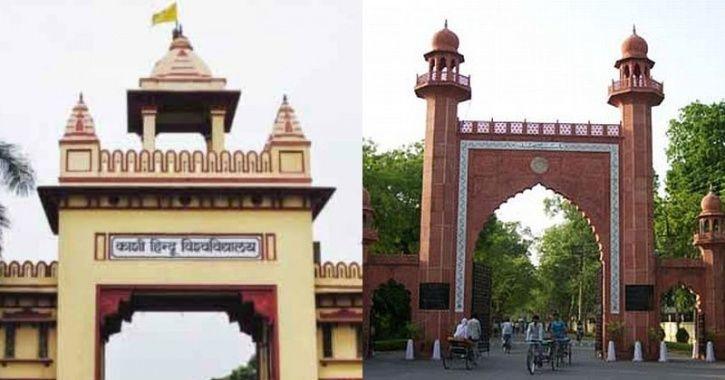As 25th December is also celebrated as the birthday of Madan Mohan Malviya- the person who conceptualized and established the Banaras Hindu University- we have compared Banaras Hindu University and Aligarh Muslim University in A Tale of Two Universities- BHU vs AMU.
Note- This is article form a Twitter thread, which can be read from the following link:
1/n- As it is the birthday of Madan Mohan Malviya- the person who conceptualized and established the Banaras Hindu University- I will present A tale of two Universities- BHU and AMU in this twitter thread, as promised in the previous thread. @ajitdatta @shubh19822 @TIinExile
— Amit Agrahari (@Amit_Agrahari94) December 25, 2019
BHU was established with the aim to fight with the ‘prevailing poverty in India and the decline in income of Indians compared to Europeans’ by Malviya (Congress president three times-1909, 18, 32) and Annie Besant (Congress president-1917) – both of whom were fighting for India’s freedom and were active freedom fighters.
On the other hand, AMU was founded by Sir Syed Ahmed Khan, who back in second half of the 19th century, declared that, “Hindus and Muslims are two Nations” and they could never live together peacefully. No doubt, his Mohammeden Anglo Oriental College (1875), which was later recognized as central university in 1920 by the British, played an instrumental role in creation of Pakistan. In fact, Jinnah (in)famously called it “arsenal of Pakistan”.
Syed Ahmed Khan asked Muslims to support the British, and actively criticized Indian National Congress, and asked Muslims to stay away from the organization.
After Independence, M. C. Chagla, a Gujrati Muslim who was Union Education Minister from 1963 to 1966, tried to remove the word “Hindu” from the name of the University (he had no plans to do the same with AMU). This led to massive protest from university students and wider Hindu community, and the government finally rolled back the decision.
While BHU had a Muslims VC in the 1980s, named Iqbal Narain (19 October 1981 – 29 April 1985), AMU never had a Hindu VC in 145 years of its existence.
In 2017, a UGC panel suggested to drop Muslim and Hindu from the names of AMU and BHU respectively. This time, the suggestion received massive backlash from the AMU students and wider Muslim community. Editorials were published in NDTV by AMU alumnus on ‘why the M word in AMU is not a problem’.
Today, BHU and AMU are two of the largest universities which receive massive grants from UGC. In FY 18, the total grant to 41 central universities was 7,315 crore rupees, of which, 1,190 crore rupees was received by BHU while 1,115 crore rupees by AMU. These two universities gallop more than 31 percent of the total UGC grant.
But, in the case of BHU, which also have almost 12,000 residential students and 16,000 days scholars like AMU, the list of prominent alumnis is very long. BHU also spends almost 4 lakh rupees per student, but, its Engineering and Technology department was granted IIT status, while the same department of AMU could not make it even in the top 100 engineering colleges of the country. For more about AMU, visit my previous thread.
The list of alumni of BHU in the field of Science and Technology is very long while that of AMU is being placed in terrorist organizations like SIMI, Indian Mujahedeen, and Popular Front of India. For cross check, just visit the Wikipedia page of BHU and AMU alumnus list, and you will be able to tell the difference.
Almost seven decades after partition, AMU has maintained its ‘minority institution’ status (the matter is subjudice), and reserves 50 percent seats for the Muslim community, and does not implement SC/ST/OBC or even the Economically Weaker Section (EWS) quota.
The tale of two universities with Hindu and Muslim in their names, receiving similar amount of funds from central government, will leave you with one concluding remark: The government needs to look at the Return on Investment (RoI) more seriously, and as taxpayers, we need to ask more questions about how our money is being spent.
